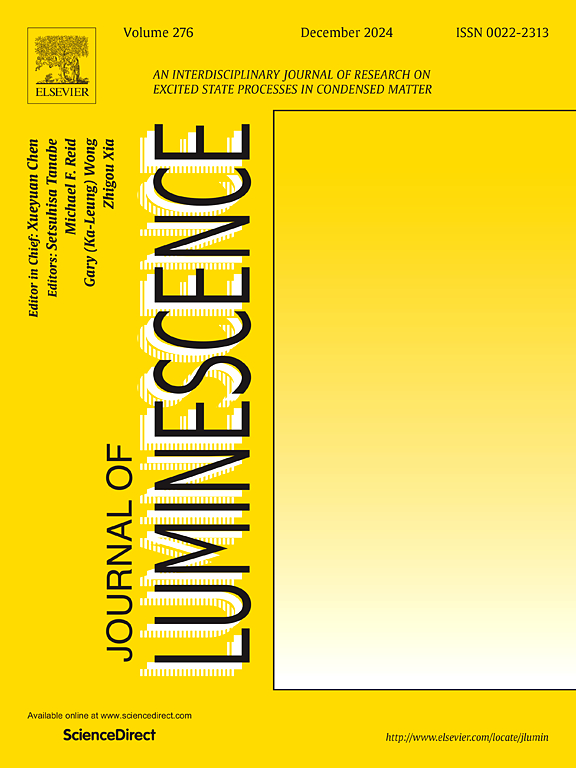取代基和二甲基亚砜浓度的影响
IF 3.3
3区 物理与天体物理
Q2 OPTICS
引用次数: 0
摘要
黄素类分子具有良好的生物相容性和光谱性质,在光物理和电化学领域得到了广泛的研究,它们大多是Alloxazine (All)的衍生物。有学者在分子水平上对水-有机混合物中All的光谱特性进行了研究。然而,对单质黄酮类水在非质子溶剂中的光物理性质和反应机理的研究还很少。本研究探讨了All的质子转移机理,并研究了取代基和DMSO浓度对其光物理性质的影响。发现溶剂和溶质之间的分子间氢键对激发态质子转移(ESPT)至关重要。当至少两个水分子和All形成三个分子间氢键(All- 2h2o)时,ESPT会自发发生。时间分辨激发态非绝热动力学表明,All-2H2O的远程ESPT是一个超快的动力学反应,质子供体N-H的键劈裂首先发生在小于100 fs的时间尺度上。这表明质子供体的供氢能力在ESPT过程中占主导地位。此外,F取代(All-F)和50% DMSO浓度将All的第一激发态转变为允许跃迁的亮态。该工作将为基于ESPT的黄素型的开发和应用提供有价值的理论见解。本文章由计算机程序翻译,如有差异,请以英文原文为准。

Theoretical investigation of the ESPT mechanism in Alloxazine: effects of substituents and DMSO concentration
Flavin-type molecules have good biocompatibility and spectral properties, and they are widely studied in photophysics and electrochemistry, most of them are derivatives of Alloxazine (All). Some scholars have studied the spectral properties of All in water-organic mixtures at the molecular level. Nevertheless, the photophysical properties and reaction mechanism of simple flavin-water in an aprotic solvent remain poorly explored. Our research delves into the proton transfer mechanism of All, as well as investigates the effects of substituents and DMSO concentration on its photophysical properties. It is found that the intermolecular hydrogen bond between the solvent and solute is crucial for excited-state proton transfer (ESPT). ESPT occurs spontaneously when at least two water molecules and All to form three intermolecular hydrogen bonds (All-2H2O). The time-resolved excited-state non-adiabatic dynamics illustrate that the long-range ESPT of All-2H2O is an ultrafast kinetic reaction, the bond cleavage of proton donors N-H first occurs on a time scale of less than 100 fs. It indicates the hydrogen-supplying capacity of the proton donor is dominant in the ESPT process. Moreover, F substitution (All-F) and 50 % DMSO concentration transform the first excited state of All into a bright state with allowed transitions. This work will offer valuable theoretical insights for developing and applying flavin-type based on ESPT.
求助全文
通过发布文献求助,成功后即可免费获取论文全文。
去求助
来源期刊

Journal of Luminescence
物理-光学
CiteScore
6.70
自引率
13.90%
发文量
850
审稿时长
3.8 months
期刊介绍:
The purpose of the Journal of Luminescence is to provide a means of communication between scientists in different disciplines who share a common interest in the electronic excited states of molecular, ionic and covalent systems, whether crystalline, amorphous, or liquid.
We invite original papers and reviews on such subjects as: exciton and polariton dynamics, dynamics of localized excited states, energy and charge transport in ordered and disordered systems, radiative and non-radiative recombination, relaxation processes, vibronic interactions in electronic excited states, photochemistry in condensed systems, excited state resonance, double resonance, spin dynamics, selective excitation spectroscopy, hole burning, coherent processes in excited states, (e.g. coherent optical transients, photon echoes, transient gratings), multiphoton processes, optical bistability, photochromism, and new techniques for the study of excited states. This list is not intended to be exhaustive. Papers in the traditional areas of optical spectroscopy (absorption, MCD, luminescence, Raman scattering) are welcome. Papers on applications (phosphors, scintillators, electro- and cathodo-luminescence, radiography, bioimaging, solar energy, energy conversion, etc.) are also welcome if they present results of scientific, rather than only technological interest. However, papers containing purely theoretical results, not related to phenomena in the excited states, as well as papers using luminescence spectroscopy to perform routine analytical chemistry or biochemistry procedures, are outside the scope of the journal. Some exceptions will be possible at the discretion of the editors.
 求助内容:
求助内容: 应助结果提醒方式:
应助结果提醒方式:


